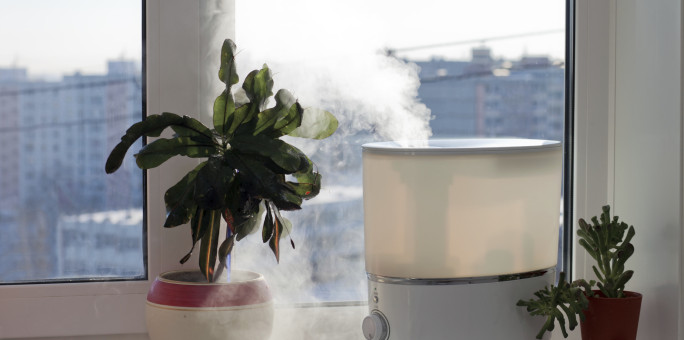If you find yourself cooped up indoors during the winter months, you may not be getting much fresh air. If the air in your home feels stale or it’s too dry, there are some things you can do to help make winter breathing a little easier.
Get a Humidifier
Cold, winter air and indoor heating systems can make everything dry. Indoor humidity can get as low as 10 percent during the wintertime, while the ideal level is 30 to 50 percent, saysConsumer Reports. A humidifier can help put some moisture back in the air. In addition to reducing dryness, the Mayo Clinic says humidifiers can help relieve dry sinuses and breathing issues that often accompany winter colds. According to Consumer Reports, humidifiers can also help ease itchy eyes, dry skin and a sore throat. And, says Consumer Reports, take steps to avoid mold and germ build-up by regularly rinsing and disinfecting the humidifier tank and changing the water, as well as following any other instructions from the manufacturer.
Use an Air Purifier
Air purifiers can help eliminate indoor pollutants, such as biological pollutants and smoke particles, according to the Environmental Protection Agency (EPA). By removing these tiny particles from your home, Good Housekeeping says air purifiers can improve home air quality. Purifiers come in different sizes and forms, says the EPA, including small, tabletop purifiers and whole-home systems. The smaller ones are typically less effective and typically cannot remove gaseous pollutants from the air, according to the EPA.
Update Your Air Filters
If you have a furnace or HVAC system, it probably has a filter. A simple way to reduce exposure to pollution particles in your home is by changing your air filters regularly. According to the EPA, air filters are available in different levels of efficiency, which is noted by a Minimum Efficiency Reporting Value (MERV) rating. Most home air filters can capture big particles in the air, including pollen, pet dander, dust and dust mites, says the EPA. There are also higher-efficiency filters available called high efficiency particulate air (HEPA) filters, but the EPA says these are not generally ideal for a residence, as they can reduce airflow in home heating systems.
Minimize Pollution
While devices such as air purifiers and humidifiers can help improve your home’s air quality, the American Lung Association (ALA) says the best way to make breathing easier is to remove the source of the indoor air pollutants. The ALA says these can include biological pollutants (such as mold, pollen, pet dander and bacteria), radon, smoke and gaseous pollutants such as carbon monoxide. These sources of pollution can contribute to health problems such as infections, allergies and asthma, according to the ALA.
To help prevent indoor air pollutants from settling in your house, Good Housekeeping suggests you:
- Don’t allow smoking inside.
- Check for and fix leaks regularly to help prevent moisture from entering the home and causing mold.
- Don’t let your car idle in your garage.
For many, winter means spending more time indoors, but that doesn’t mean you have to sacrifice fresh air. Taking steps to help improve your home’s air quality during the coldest months may help you breathe easier until spring rolls around.




![9b27ffdff2dc4e0283fb2822e25353cf[1]](http://insurancekennesawga.net/wp-content/uploads/2016/01/9b27ffdff2dc4e0283fb2822e25353cf1-60x60.png)




Leave A Comment